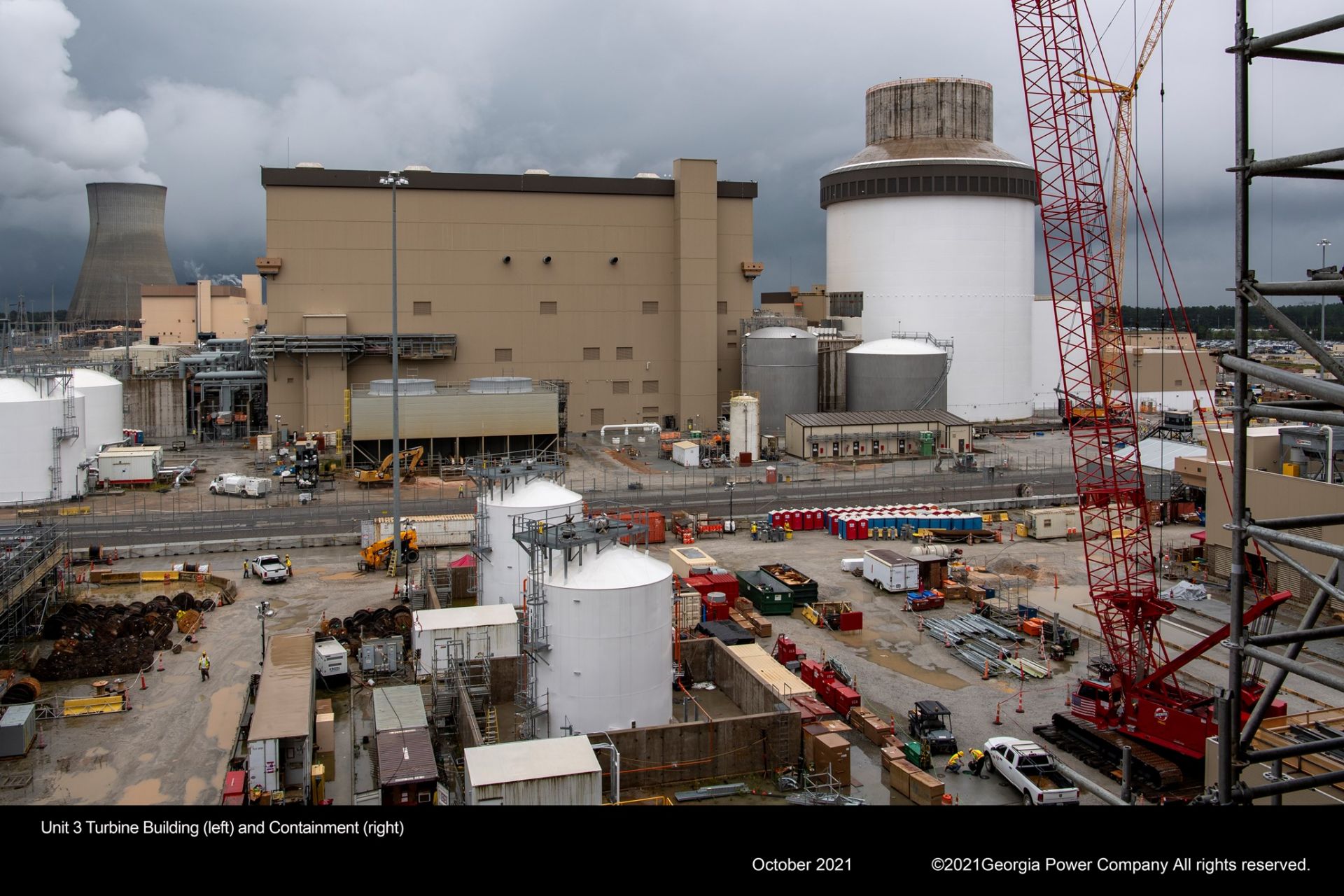The Hunterston B nuclear power station in 2018. (Photo: Thomas Nugent/CC BY-SA 2.0)
Unit B1 at Scotland’s two-unit Hunterston B nuclear power plant was taken off line for good on November 26 after nearly 46 years of operation. A 490-MWe advanced gas-cooled reactor, the unit entered commercial operation in June 1976. Its companion AGR, Unit B2, which entered operation in March 1977, is scheduled for retirement in January.
Artist’s rendering of a BWRX-300 plant. (Photo: GE Hitachi Nuclear Energy)
Ontario Power Generation (OPG) has selected GE Hitachi Nuclear Energy (GEH) as its technology partner for the Darlington nuclear new-build project. The companies will work to deploy GEH’s BWRX-300 small modular reactor at OPG’s Darlington nuclear plant, located in Clarington, Ontario.
Jamie Weaver with the neutron depth profiling instrument. (Photo: T. Barvitskie/NIST)
The newest generation of lithium-ion batteries now being developed uses thin-film, solid-state technology and could soon safely power cell phones, electric vehicles, laptops, and other devices. However, like all batteries, solid-state lithium-ion batteries have a drawback: Impedance—electrical resistance—can build up as batteries are discharged and recharged, limiting the flow of electric current.
The Vogtle-3 turbine building (left) and containment (right) in October. (Photo: Georgia Power)
The Nuclear Regulatory Commission will increase its oversight of Vogtle-3—one of the two Westinghouse AP1000 reactors under construction at the Vogtle nuclear power plant in Waynesboro, Ga.—after finalizing two inspection findings involving the unit’s safety-related electrical cable raceway system. Vogtle’s operator, Southern Nuclear, was informed of the decision in a November 17 letter.
The agency had launched a special inspection at Vogtle-3 in June of this year to determine the cause and extent of construction quality issues in the raceway system, which consists primarily of conduits and cable trays designed to prevent a single event from disabling redundant safety-related equipment.
SwRI engineers used LIDAR point cloud data to reconstruct a high-resolution image of a facility that houses electric turbines at the nuclear power plant. 3D cubes, or voxels, on the left provide spatial information on the turbine facility. Point clouds were reconstructed to create the high-resolution image of the turbines on the right. SwRI specializes in data visualizations to identify damage and potential hazards following accidents at nuclear power plants and other hazardous facilities. (Graphic: SwRI)
During the EnRicH 2021 European Robotics Hackathon, Southwest Research Institute’s unmanned aircraft system (UAS or drone) explored and mapped the interior of a nuclear power plant, detecting radiation sources autonomously, without the aid of a human pilot.
SwRI’s UAS technology can potentially assist in life-saving search-and-rescue missions and hazardous inspections at industrial facilities and infrastructure following natural disasters and other incidents.
Diablo Canyon nuclear plant. (Photo: PG&E)
Last April, Entergy had to close its Indian Point nuclear plant. That’s despite the plant’s being recognized as one of the best-run U.S. nuclear plants. That’s also despite its 20-year license extension process having been nearly completed, with full support from the Nuclear Regulatory Commission.
This closure was due in large part to opposition by antinuclear environmental groups. These groups also mobilized existing negative public opinion on nuclear energy to get politicians to oppose the plant’s license extension. Another factor is unfair market conditions. Nuclear energy doesn’t get due government support—unlike solar, wind, and hydro—despite delivering clean, zero-emissions energy.
November 24, 2021, 2:30PMNuclear Newsthe U.S. Army Corps of Engineers, Baltimore District, Deactivated Nuclear Power Plant Program staff The Sturgis is towed from the Galveston, Texas, pier to the shipping channel on September 25, 2018, as it heads toward Brownsville, Texas, for final shipbreaking and recycling. Over the past three years in Galveston, the U.S. Army Corps of Engineers has been implementing the challenging and complex effort to decommission the MH-1A—the deactivated nuclear reactor that was onboard the Sturgis vessel.
The U.S. Army Corps of Engineers (USACE), Baltimore District, is home to the North Atlantic Division’s Radiological Health Physics Regional (RHPR) Center of Expertise, which is leading the decommissioning of Army reactors.
From 1956 to 1976, the Army’s nuclear power program operated several small nuclear reactors to confirm the feasibility of their meeting military power needs on land. Three Army reactors were deactivated in the 1970s and placed into safe storage awaiting future decommissioning.
Millstone nuclear power plant
The Nuclear Regulatory Commission has granted Dominion Energy’s request for an increase in the generating capacity of Millstone-3. The Richmond, Va.–based utility had applied for the power uprate last November, requesting an increase of approximately 1.6 percent.
NRC staff determined that Dominion could safely increase the reactor’s heat output, primarily through more accurate means of measuring feedwater flow, according to a November 18 press release. The NRC’s safety evaluation focused on several areas, including the nuclear steam supply systems, instrumentation and control systems, electrical systems, accident evaluations, radiological consequences, fire protection, operations and training, testing, and technical specification changes.
Artist’s concept of a fission surface power system on Mars. (Image: NASA)
NASA and Idaho National Laboratory have just opened a competitive solicitation for U.S. nuclear and space industry leaders to develop innovative technologies for a fission surface power system that could be deployed on the surface of the moon by the end of the decade. Battelle Energy Alliance, the managing and operating contractor for INL, issued a request for proposals and announced the news on November 19. Proposals are due February 17.
Westinghouse president and CEO Patrick Fragman and Energoatom president Petro Kotin sign a contract for the first AP1000 in Ukraine. They are joined by U.S. charge d’affaires to Ukraine Kristina Kvien and Ukraine energy minister Herman Halushchenko. (Photo: Westinghouse)
Westinghouse Electric Company and Energoatom, Ukraine’s state-owned nuclear utility, signed a contract in Kyiv yesterday outlining the details of an agreement to bring the Westinghouse AP1000 reactor to Ukraine’s Khmelnitsky nuclear power plant.
According to a Westinghouse press release, the contract initiates engineering and procurement of long-lead items for the reactor.
Signing the contract were Patrick Fragman, president and chief executive officer of Westinghouse, and Petro Kotin, Energoatom’s acting president. U.S. charge d’affaires to Ukraine, Kristina Kvien, and Ukraine energy minister Herman Halushchenko also attended the event.







 In September, cable television’s Science Channel aired an episode on power plant catastrophes as part of its series Deadly Engineering, with one principal segment on the 1979 Three Mile Island accident. The episode contains several inaccuracies and distortions—perhaps the biggest mistake being that the TMI accident was featured in Deadly Engineering at all, since no deaths or long-term adverse health trends resulted from the accident.
In September, cable television’s Science Channel aired an episode on power plant catastrophes as part of its series Deadly Engineering, with one principal segment on the 1979 Three Mile Island accident. The episode contains several inaccuracies and distortions—perhaps the biggest mistake being that the TMI accident was featured in Deadly Engineering at all, since no deaths or long-term adverse health trends resulted from the accident. and containment (right).jpg)





